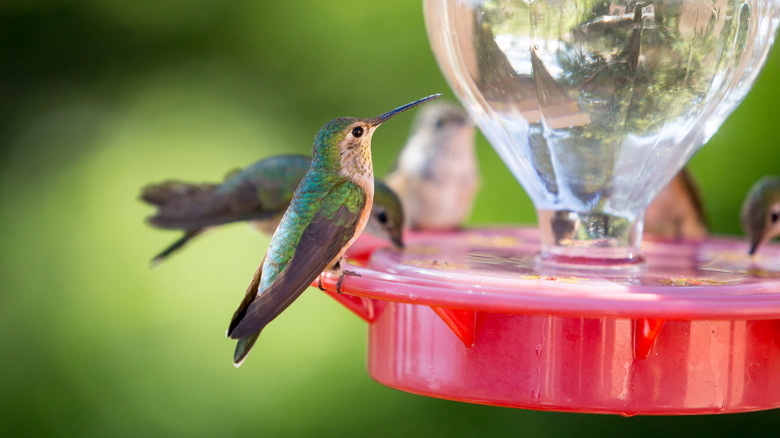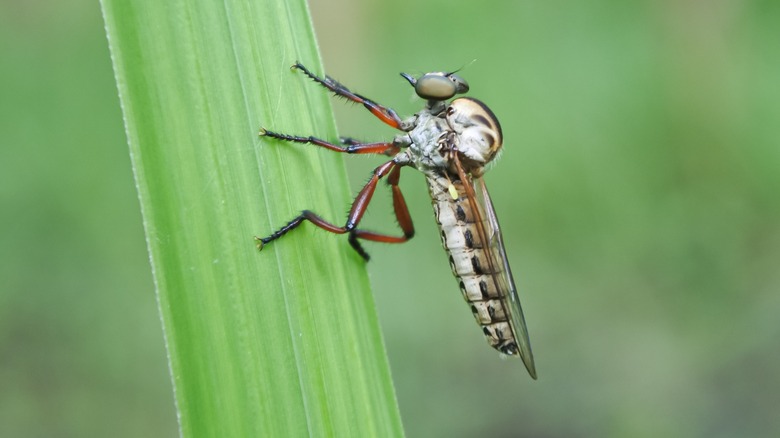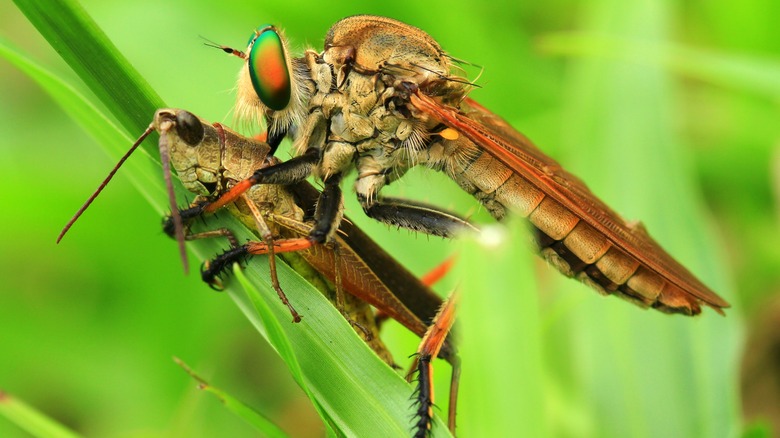This Carnivorous Fly Is A Bad Sign To See On Hummingbird Feeders
Aggressive, carnivorous, cannibalistic — all terms that can be used to describe the robber fly. More than 1,000 different types of robber flies (family Asilidae) live around North America, and some grow up to 1 ½ inches long. If the name robber fly makes these winged insects sound devious, consider their alternate moniker: assassin fly. These hump-backed fliers with large eyes get their menacing reputation by swooping down on prey before paralyzing it with a sting, particularly when it comes to other winged insects. Will they also feed on hummingbirds as they're flitting around backyard feeders? In some instances, yes. So, just like seeing a praying mantis on your hummingbird feeder, it can be a cause for concern when you notice a robber fly.
Since other insects seeking nectar, like bees and butterflies, sometimes buzz around hummingbird feeders along with the intended birds, that can draw the attention of robber flies, and possibly lead to one of them attacking a hummingbird. If you wanting to protect the tiny birds frequenting your yard, learning more about the robber fly's habits can help you tackle that task.
More on the dining habits of robber flies
When a robber fly feeds, it dives down in a sneak attack style, hovering over its victim with spiny legs before injecting it with paralyzing toxins and digestive enzymes that turn the prey's internal tissues into liquid. With the mouth still in place, the stinger becomes a sucker allowing it to feed until all that's left is an empty carcass. These little predators will assault lots of different types of flying insects, including dragonflies, beetles, butterflies, bees, wasps, and other types of flies. Some especially enjoy dining on grasshoppers, too. A larger robber fly will even ravage a smaller version of itself. These predators will attack just about anything if they think they can make a meal of it, which includes hummingbirds when the timing is right.
Since most hummingbirds are about 3 to 4 inches long, they're a little large to regularly fall victim to these winged assassins, measuring around 1 ½ inches at their largest. When an attack does happen, hummingbirds have been known to fight off robber flies using their sword-like beaks and rapidly beating wings. So, yes, robber flies can be one of the predators eating hummingbirds in your yard, but it thankfully doesn't happen all that often.
Keeping robber flies away from hummingbird feeders
There are actually lots of different types of assassin bugs that can be good for your garden. Robber flies eat some of the same insects, like stink bugs, so having them around isn't always a bad thing. However, if you're concerned about keeping robber flies away from your hummingbird feeder to make sure your feathered friends are kept safe, there are some steps you can take.
If you notice robber flies or other insects that might attract them frequenting your feeder, as a first step, you can try moving it to a new location 10 to 15 feet away. Insects tend to stick close to the same spots when feeding, but hummingbirds will travel farther and continue to find the feeder. You can also consider switching to a saucer-shaped feeder for your hummingbirds if you don't already have one. This type leaks less so bugs aren't drawn to them as readily and when the sugar water is kept at a lower level, insects like bees and wasps won't be able to reach, while hummingbirds will still freely partake with their long beaks and tongues. With fewer insects that robber flies easily dine on near the feeder, they'll likely look elsewhere for their prey and leave the hummingbirds you love to watch alone.


